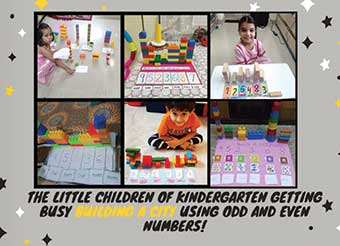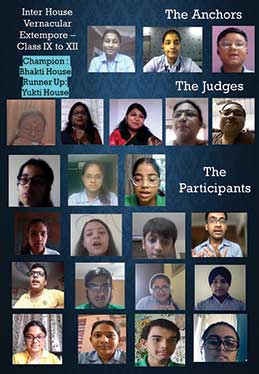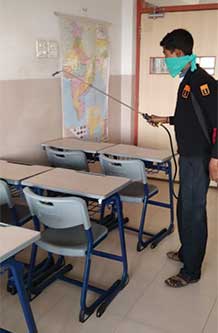Suvina Shunglu
The abrupt closure of our school necessitated an equally sudden decision to transform into a virtual school. I was driven by the compelling thought of not keeping our school closed especially because of a lockdown dictated by a tiny virus. That learning must go on was the driving force behind this conviction.
2020 – The annual academic term had not ended. The senior teachers were still collating and finalizing their reports. The junior school teachers had sent the reports and were all set for their prize-day practices, cards printed, parents invited, colourful ribbons tied around prize books and inspiring speakers fixed for each of those important days and parent get-togethers. The excitement around the closing of the year was palpable. News had been filtering in from China and other nations about countries going into lockdowns and we all had a sense of foreboding.

My conviction to begin early was facilitated by finding a resource person to train our staff. We began immediately. The school’s faculty was summoned to an emergency meeting, informed about going online and the training started the same day in our computer labs: from how to download and use new learning apps, new software to uploading content on a new school YouTube channel. Our school’s interactive website and IRP (same as ERP or Enterprise Resource Planning System) were used to send the final school reports to the parents of children in senior school in soft copies. The teachers began working in full steam: preparing lessons, videos, power-point presentations and assignments from home. They were guided patiently day and night by a team of academic coordinators and computer science teachers through conference calls and emails.
The beginning of April 2020 saw the launch of online classes for junior and middle school. Almost 85 percent of students joined their virtual classes and submitted responses in a single day. Undoubtedly, many experienced difficulties in logging in or faced technical problems which were rectified by vigilant coordinators and teachers at the help desk. Meanwhile, our students from this advantaged sections of society were using their parents’ mobiles to download and do assisted work with the teacher-in-charge of their inclusion. We raised funds in the summer to buy tabs for 30 students who could not afford smart phones or laptops and this filled in a gap that had been felt in ensuring continuity in their online classes. The entire staff and teachers came forward to help with daily necessities, mobile data and medicines for these students and their families.
Senior classes were the first to get down to serious studies and within three days all the students had logged into their virtual classes and began submitting assignments and clearing their doubts. Parallel lines of communication were set up with class teachers through class groups on their mobiles. Early on,a teacher’s horror met with the students’ excitement as our Class 9 English class was ‘zoom bombed’ by cyber pirates leading us to explore safer platforms and finally move to Teams and Meet. These were slower, more data consuming platforms, but they enabled us to breathe easy.
In this absolutely unforeseen and almost bizarre crisis, the meaning of leadership also seemed to have acquired additional layers and shades. I realized by the middle of 2020 that I was not merely running a school; I was on the threshold of creating a new school with its roots in physical reality but reaching up and expanding into virtual space. In this unfamiliar terrain, I would not just have to lead my teachers and administrative staff, students and parents, but also lead them through a crisis where the normal and the familiar are turned on their heads and unrecognizable. All of a sudden disease, death, depression, the breakdown of social interaction became forces one had to consider together with curriculum planning in virtual space. It did not take me long to understand the critical necessity of building a team which will acclimatize itself quickly to the new environment and be responsible for areas as diverse as counselling, teaching a new language to survive and then thrive in a new ‘world-order’, mentoring a large spectrum of individuals and create in record time new methods to disseminate learning.

In May, we learnt to devise e-feedback forms where every aspect of school, logistics, delivery, provision of breaks was floated. These gave us precious insights into the varied challenges faced by parents, remote locations, poor connectivity, small homes and so on.
We have received responses from parents saying they were sceptical about working in this new scenario but were reassured once they saw their children responding to teachers. We have also received mails expressing difficulties and were constantly improvising to address these concerns and find solutions. There was constant review and reflection on weekends to evaluate ourselves, unravel feedback and improve our performance. We reduced our holidays: what would children do if they can’t go out? Therefore, we continued to teach through the summer of 2020.
When the Amphan cyclone pounded Bengal, tore down millions of trees and network was impaired throughout the city and state, it completely stalled our plans with no solutions in sight till the lines were restored. Our school counsellors and mentors were available for students to discuss any concern or anxiety at the help desk. Based on SEN (Special Needs Department) recommendations, students with special needs or learning in modified curriculums were being sent modified work through personal emails by their special educators. Life skills mentors worked on conversations, counselling and group therapy. We made sure we were there to address any concern.
As the head of the school which no longer existed physically, I felt it was imperative that we focus on easy, regular, structured communication with students and parents, constant upskilling of staff and teachers to deal with unknown situations, problem solving and troubleshooting even when keeping our belief and ethos in being an inclusive, compassionate and values-based school. Letters and recorded messages to parents were uploaded by the principal on the website and the official school Facebook page. Mobile text messages were sent to orient them about these school initiatives. We started regular digital newsletters sharing school news and student achievements with parents. We also couriered the printed school diary and the magazine still lying in school from March.
Content prepared by teachers and age appropriate reading materials were constantly being prepared in the absence of school books, keeping in mind the pedagogical principles of learning from the concrete to the abstract and simple to complex. They were guided to prepare open-book assignments to evaluate higher-order skills critical to these times. We took small steps to consciously reduce competition from the process of evaluation. Our co-curricular team prepared short videos or started live classes for yoga, karate, dance, aerobics and other fitness programmes to break the monotony of an academics – only routine.

New e-report cards were designed which reflected parent-supervised learning for the younger students. The new assessment included sections of parent feedback on independent or assisted work where their contribution featured in the new report cards. Parent-teacher meetings took months to finish with each teacher talking to single parents or families at length. Parents expressed their satisfaction in this procedure as they found a ready ear to listen to their apprehensions and concerns.
Since our school emphasizes the nurturing of life skills and values, this became an added area of focus once the academic classes were mastered. Students started writing poetry, blogging and helping our less privileged students to study English in the evenings or help them learn how to grow micro greens on their window sills, to recycle or to create apps through newly installed software guided by their Tinkering and AI teachers. Gradually, school investiture, assemblies, festivals, and online celebrations became the new normal with live streaming for all to witness.
Nearly two years have passed since the advent of our transformation from a physical to a virtual school, the anxiety of providing online classes has been replaced by a sense of fatigue with all things online. We do realize and grudgingly accept that it has some merits: primarily of cutting down geographical boundaries, providing us access to human and technical resources across the world and in saving costs of logistics and time for every little decision. We have survived by continuously learning and evolving, but not a day passes when we do not pray that we will return to our real and much-loved workplace soon.
In 2021 November, with the government unlock, the senior students started coming to school in small batches for hybrid classes. I feel I can see some light of normality approaching. Maybe a light still dimmed with trepidation and nervousness, but surely there.
In the staggered physical parent-teacher meeting for junior school held recently where the child came with the parents, it was heart-rending to see the shining eyes of each child making contact with another child who responded with the same brightness and, then their visual contact sparking off sounds of excited words and laughter. Yes, all our sanitization protocol is in place, all the government and health department’s diktats of safety and hygiene have been memorized, applied, practised, tested again and again.
The teachers are now coming to school and teaching children far away in virtual space. Now, we, as it happens in so many cherished fairy-tales, need the children’s physical presence to bring our school back to life and restore happiness once again in our realms.
The author is Founder Principal, Sri Sri Academy, Kolkata. She can be reached at s.shunglu@ssa.org.in.
Related Articles
